How To Take Amazing Photos of the Solar Eclipse
"Hearst Magazines and Yahoo may earn commission or revenue on some items through these links."
On August 21, a huge swath of North America will experience a once-in-a-lifetime celestial event—a total eclipse of the Sun. This Moon hasn't gobbled up the Sun in this neck of the woods for more than 40 years, and though you could certainly just live life and soak in every second of this historic event, you might want to create a more lasting memory.
But this won't be as easy as snapping a selfie. If you're hoping to capture the eclipse with your camera, this is what you need to know.
Before we dig into the finer details, the most important thing to remember about all of this is NEVER LOOK AT THE SUN WITHOUT PROTECTION. Looking at the Sun with your naked eye can harm your vision, and channeling the Sun's rays through a DSLR viewfinder can damage your equipment and even cause blindness. So be careful, and try these techniques at your own risk.
Photographing The Sun
First things first—we need to figure out how to photograph the Sun. Although this isn't your average photo shoot, the camera remains the single most important piece of equipment. For this tricky shot, I recommend a DSLR or mirrorless camera paired with a telephoto lens and a 2x extender or telescope. You can also get good results with a point-and-shoot camera attached to a spotting scope or a digital camera with a long zoom.
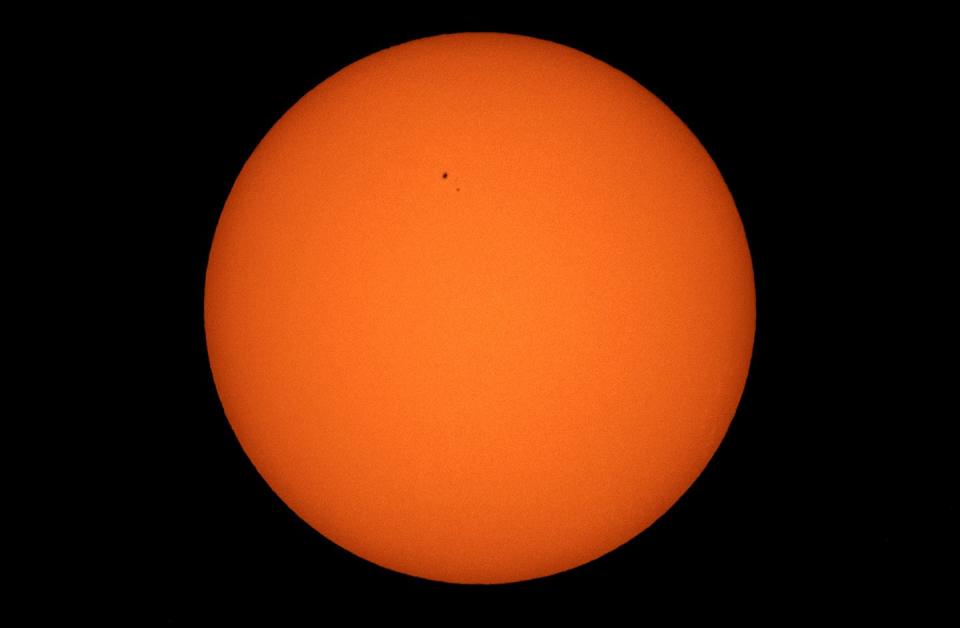
It might be the most brilliant orb in the sky, but the Sun is actually pretty small, so to capture details on the surface like sunspots you need a long focal length. The minimum focal length I recommend is about 600mm (35mm frame equivalent) since the Sun usually fills the frame top to bottom at about 2500mm. A fun (and safe) way to test a lens is to try photographing the Moon first. Depending on the day, the Moon is roughly the same size as the Sun and you get a good idea about what is the best lens for you.
With any telephoto lens, mounting on a sturdy tripod helps keep the Sun in the frame. Just be sure that the recommended weight on the tripod can handle the weight of the camera, lens, or telescope. And if your camera or lens has image stabilization, you're going to want to turn that off.
Practice Safe Viewing
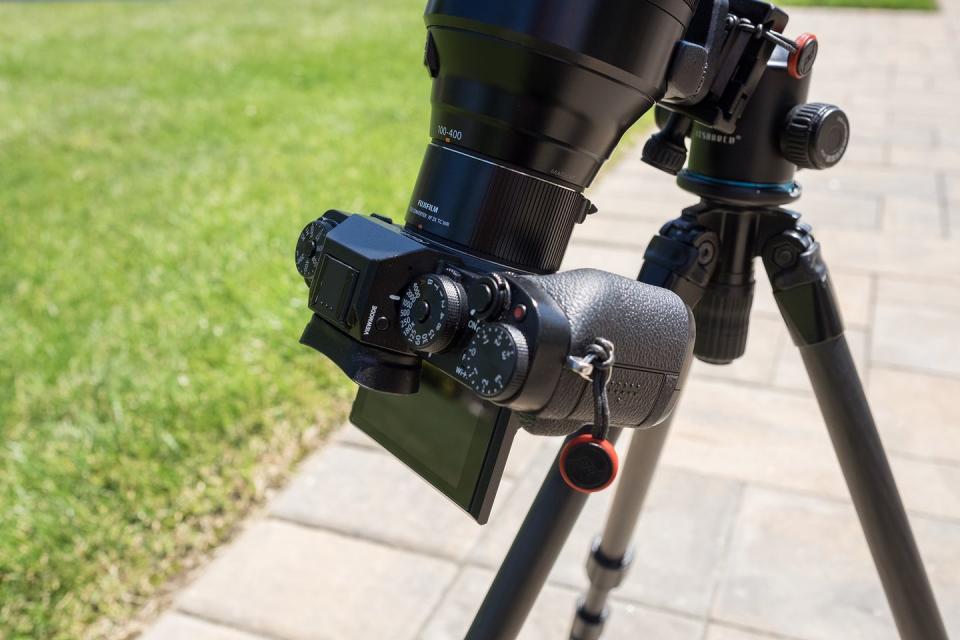
There are a variety of filters available that you can use to view and photograph the Sun. Searching "solar filter"in Amazon returns several options for your camera, telescope, as well as glasses for viewing the Sun without a camera. The glasses are critical if you are planning to view a solar eclipse. It's common to think that looking at the Sun during the eclipse is safe for your eyes without protection, but it's not.
The Sun is still way to bright to photograph without some type of filter and there are several options available. You can buy a mylar filter sheet and make your own filter holder with cardboard and some tape. If you are not DIY inclined, it's available with a bracket that is meant for a telescope but the right size for your lens will work just fine. You can also use an ND 100000 filter if you are using a camera lens that accepts a threaded filter on the front. When using the ND 100000 filter IT IS NOT SAFE for to use the viewfinder. Use the live view mode if you plan to use the ND 100000 filter.
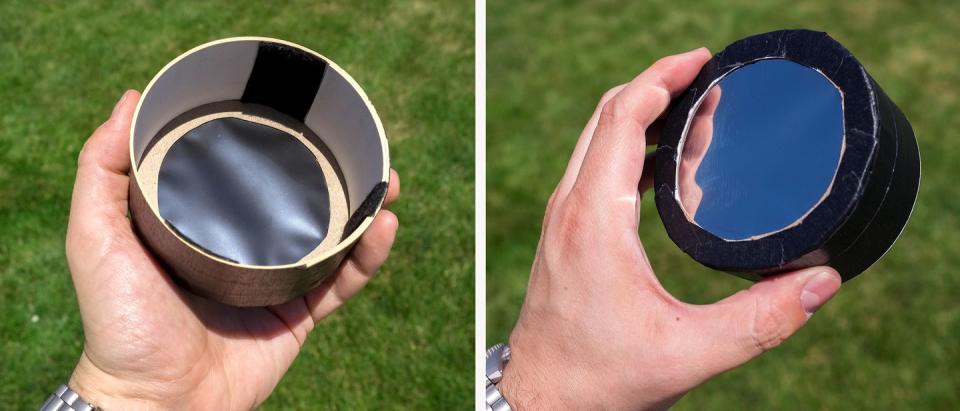
Now, you need to find the Sun. Although that might be easy with standard focal lengths it can be tricky. But if you look at the camera's shadow, you can get a general position then pan slowly around using the cameras live view mode to center the Sun in the frame.
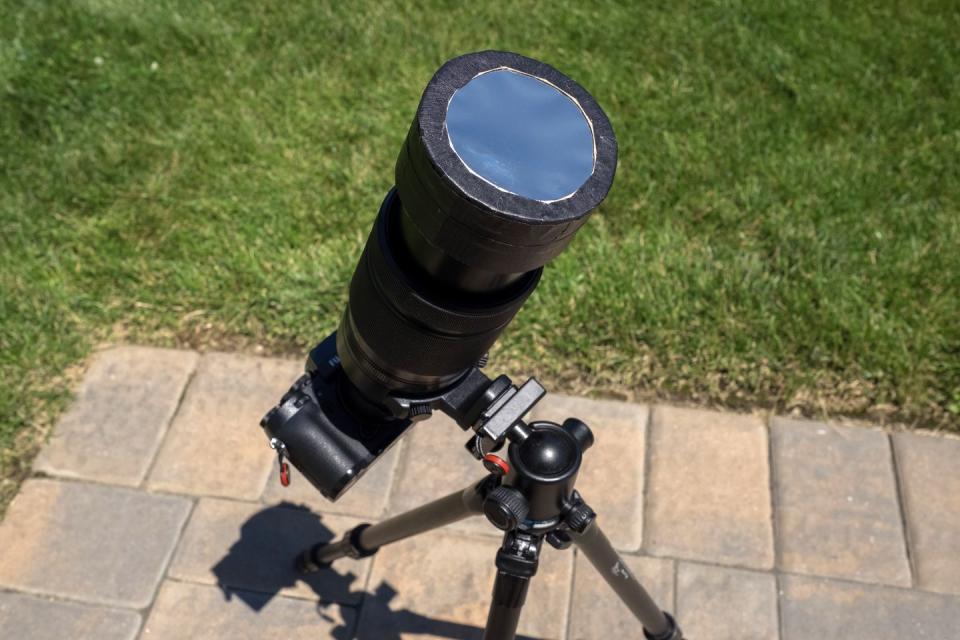
Although a blazing summer Sun seems to hang still in the sky, it'll move out of frame pretty quickly when you're looking through 600-1000mm focal range. There are expensive tracking devices that can track the movement of the Earth to keep the Sun or stars in frame, but I found that with some practice before the main event you can get the hang of it.
Once you have the Sun in frame, carefully focus using manual focus and the live view mode on your camera screen. You can use the SoHO app or the SoHO site to see if there are currently any prominent sunspots that you can use to focus on the surface.
Also it might look like the Sun is unobscured on a clear day, but even if you have the highest quality optics and you are perfectly in focus the Earth's atmosphere can cause distortion, blurring, or can smear your image. Plan to shoot at least 10-20 rapid-fire shots each time so you can pick the best.
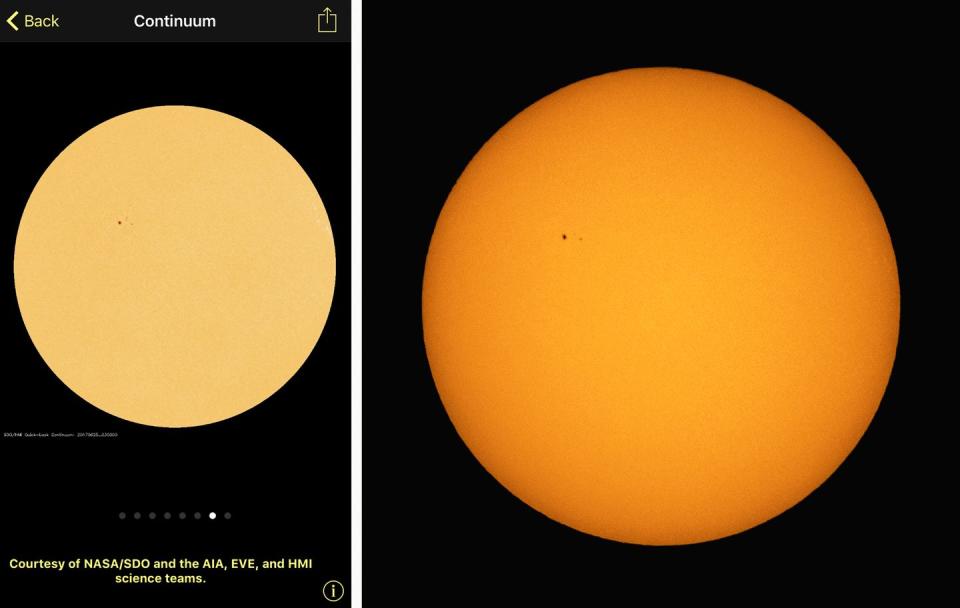
Photographing an Eclipse
On August 21, millions of people will experience the eclipse in a slightly different way, whether you see a partial eclipse or you're lucky enough to be in the path of totality. If you're one of the latter (and you should try to be), there are a few things you need to adjust—and you'll need to do them quickly.
You'll want to shoot several photos at each stage of the eclipse. Shoot camera RAW files and bracket your shots (shoot one or two stops above and below what you think looks right on your screen). Set the ISO to 800 or higher on a full frame sensor. Open the lens aperture to its largest size (probably around f4 depending on your lens). The goal is to get a shutter speed of 500th -1000th of a second or more. This will help keep the image sharp and reduce the amount of distortion from the atmosphere.

During the partial stages of the eclipse, exposure will stay the same right up to the point where the Sun is just a small sliver. The exposure will change a little in the last few moment before it's gone so highly recommend bracketing these shots if you haven't been for the other stages.
Once the Sun is completely covered by the Moon, the scene will be much darker and you will see stars and the Sun's corona. You can now remove the filter from the camera, so you can let in the maximum amount of light. If you have a zoom lens, consider getting a wider shot so the full extent of the corona will fit into the frame. The corona itself has a huge range of brightness so there is a range of exposure times that will capture it. A good starting point for a photo of the corona would be ISO 100, f/8 and then adjusting shutter speed from 1/2000 of a second to 2 full seconds.
Change the shutter speed after each exposure by several stops at a time. Try 1/2000, then 1/500, then 1/125, then 1/30, then 1/15, then 1/4, then 1/2, then 1 second then 2 seconds. This allows you to choose a single interesting exposure or create an HDR image using several or all of the exposures.
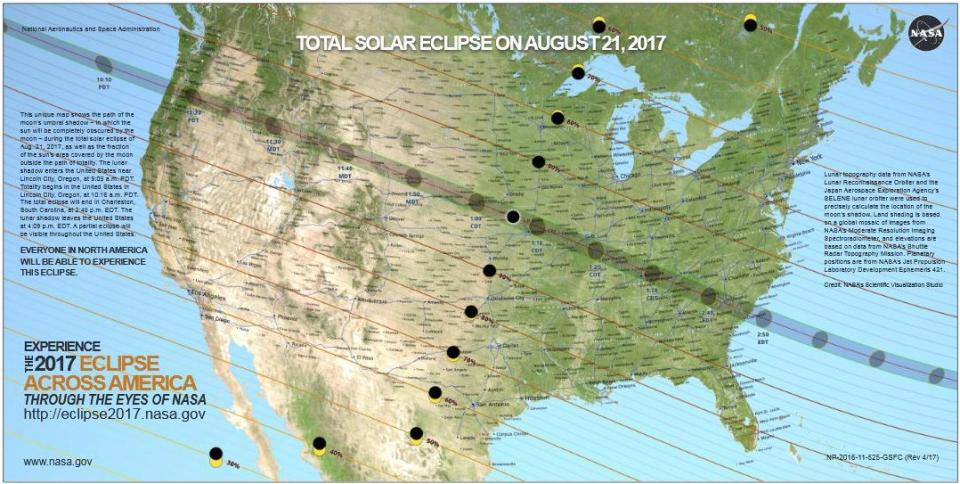
Make sure you practice these steps before the actual event and even consider stopping all photographs at the halfway point of the eclipse so you can look around and enjoy the event with your own eyes. It'll only be few minutes, and you're not going to want to miss it.
Once the Sun starts to reemerge from behind the Moon, it's time to put the camera filter back on and take more photos of the remaining stages of the partial eclipse. These will last about and hour and a half before and after the actual eclipse.
Be sure to check out Hudson Henry YouTube channel as well. He has a great video explaining the camera settings during the eclipse.
After the Eclipse
After you have made your exposures and selected the sharpest shots, you can use photo editing software like Adobe Photoshop, Adobe Lightroom, or even an app on your phone to make exposure adjustments, boost the contrast, and crop the image. If you use Photoshop, I recommend using adjustment layers instead of changing the original image. The adjustment layer is a nondestructive layer above the original that lets you make changes and readjust without breaking down the original. I like to use the levels adjustment layer but you can use curves or just the brightness contrast. You can also stack multiple adjustment layers like "hue" and "saturation" on top of the levels adjustment to fine tune the image to what you think looks best.
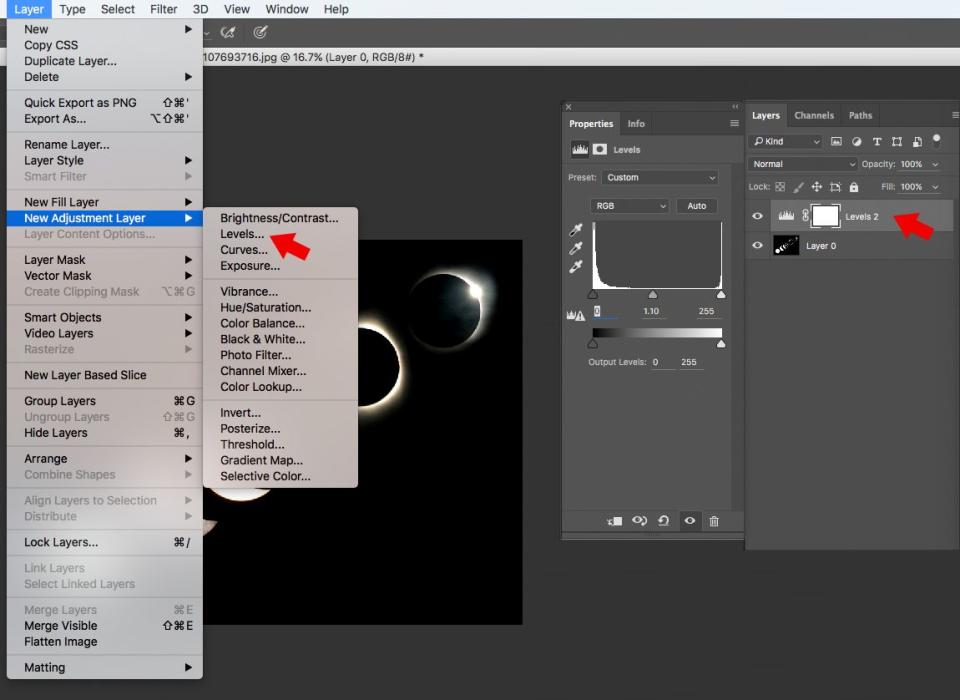
If you took bright photos and dark photos of the eclipse corona you can use HDR software like Photomatix to create a composite image. Our brains allow us to see details in the dark shadows all the way up to the very bright areas all at the same time. Modern cameras have become better at doing this but are still very limited with the exposure they can reproduce in a single shot. Photomatix or other HDR applications let you combine the light photos and dark photos into one image that is closer to what you saw with your own eyes.
A total soar eclipse is a rare event, and North America won't see another one until April 8, 2024. Get out there, get some photos, and don't forget to drink it all in.
Fingers crossed for clear skies!
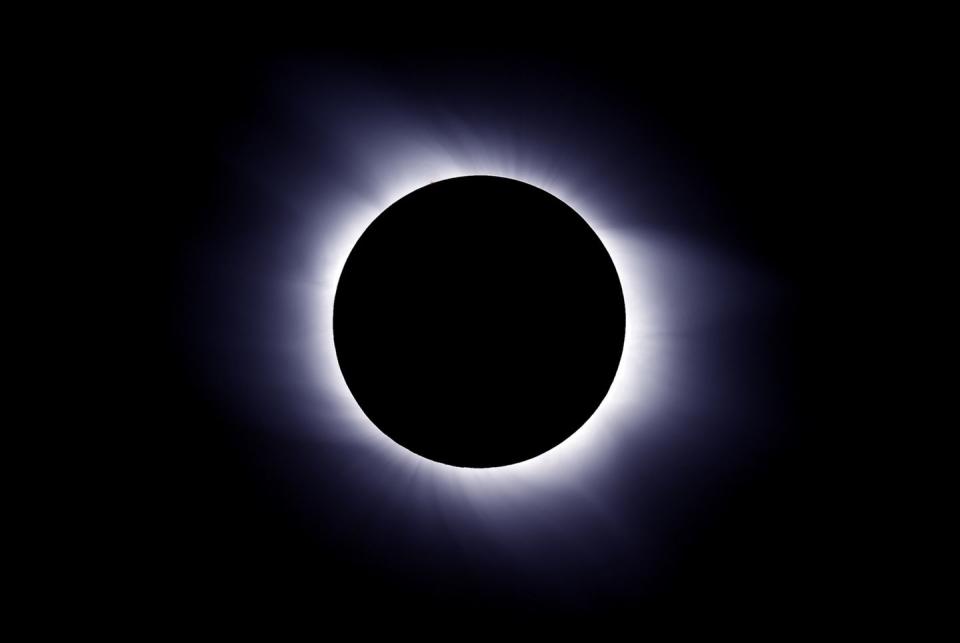
You Might Also Like

